-

人教版高中地理必修1第五章第一节自然地理环境的整体性说课稿
学生已学习水循环和岩石圈物质循环,对地理环境要素有初步的认识,对物质迁移和能量的交换有一定的了解,已具备基本的地理阅读分析、提取信息的能力。但学生还缺乏综合分析问题解决问题的能力,通过案例来帮助学生对自然地理环境整体性的认识,还需要补充光合作用、分解作用等知识,并进一步培养学生综合分析地理问题的能力。三、说教法案例教学、启发式讲授四、说学法学生原有的地理基础知识不扎实,学习地理方法简单;但学生思维活跃,有强烈的求知欲,所以在学习的过程中,老师应充分利用这一点,调动学生的积极性,激发学生的学习兴趣。学案导学法;合作探究法;案例分析法等,自主学习、合作学习,培养学生的主动学习的能力、团队精神,增强学习效果;体会自然地理环境的整体性和复杂性,将学习目标内化到行动上。
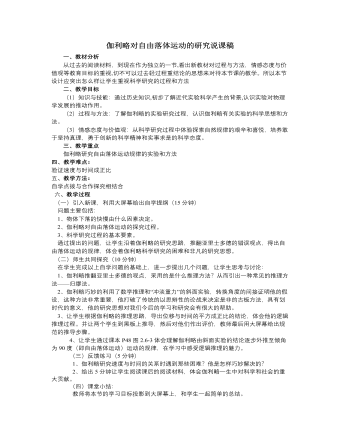
人教版新课标高中物理必修1伽利略对自由落体运动的研究说课稿
(三)反馈练习(5分钟)1、伽利略研究速度与时间的关系时遇到那些困难?他是怎样巧妙解决的?2、给出5分钟让学生阅读课后的阅读材料,体会伽利略一生中对科学和社会的重大贡献。(四)课堂小结:教师将本节的学习目标投影到大屏幕上,和学生一起简单的总结。(五)课后作业1、利用现代的测量仪器设计出一个研究自由落体运动规律的实验,写出需要的器材和实验过程。2、请学生再总结出一些科学研究中常用的思路和方法。通过这两个作业,进一步提高学生的科学研究的意识和素质。本设计所涉及到的科学研究方法:1、归缪法——伽利略用亚里士多德的观点推翻了翻亚里士多德的观点。2、转换法——伽利略用数学推理和斜面实验间接证明他的假设。3、逻辑推理法——用数学方法推理出速度正比于时间则位移与时间二次方成正比。4、外推法——由斜面实验外推至自由落体运动运动规律
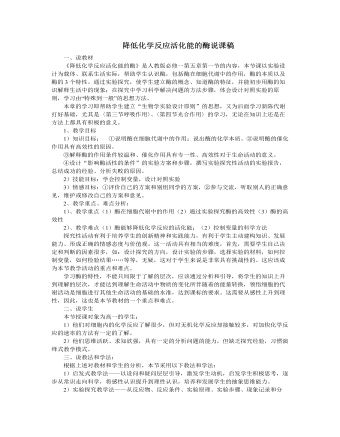
人教版高中生物必修1降低化学反应活化能的酶说课稿
实验是学习生物的手段和基础,是培养学生分析问题、解决问题的能力及创造能力的载体。新课程倡导:强调过程,强调学生探索新知识的经历和获得新知的体验,不能在让教学脱离学生的内心感受,必须让学生追求过程的体验。并且每年高考都有对生物学实验的考查,而且比例越来越重,而学生的失分比例大,主要在于他们没有完整的生物实验设计模式,考虑问题欠缺,本节安排在第二课时完整讲述高中生物学实验设计,是以学生在第一课时和前面探究实验接触的前提下,完整体验生物实验设计模式,为后面学习探究实验打下基础,也为培养学生分析问题、解决问题从一开始就打好基础。五、说教学过程:第一课时联系生活,导入新课,激发学生学习兴趣→细胞代谢→问题探究,酶在代谢中的作用,掌握科学实验方法→酶的本质,运用方法,自主归纳获取新知→小结练习,突出重点易化难点
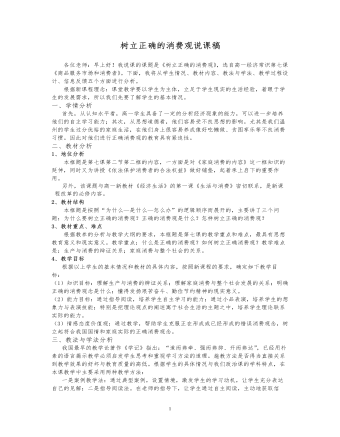
人教版高中政治必修1树立正确的消费观说课稿
(三)师生互动、巩固知识、课堂小结为培养学生的抽象思维能力和独立思考的能力,课堂小结让学生来总结,教师要向学生提示本课题主要讲了几个问题。并推荐一位擅长书法的同学书写。一方面可以展现该同学的书法技能,发挥其特长;另一方面对于其他同学也起到了模范带头的作用。(四)板书设计:板书设计准备采用条目式板书,条目式板书的作用是条理清楚、简练,一目了然,并且能够为学生做笔记乃至以后的复习提供方便。二、树立正确的消费观1、为什么要树立正确的消费观?(1)理论依据:生产与消费的辩证关系;(2)现实分析:关系到社会的整体利益;(五)课后作业注意观察自己的家庭消费情况,记录某时期的家庭各项消费支出,根据所学理论,判断自己家庭的消费结构是否合理。这有利于形成学生观察生活和观察身边的经济现象的习惯,培养思维能力和理财能力。又可以增强政治课的兴趣。
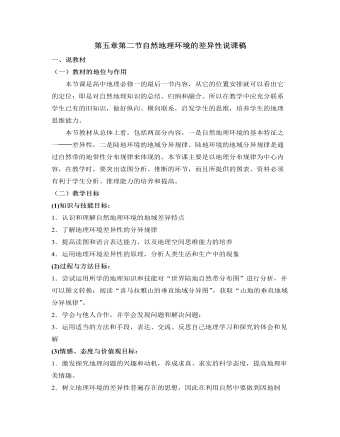
人教版高中地理必修1第五章第二节自然地理环境的差异性说课稿
(一)教材的地位与作用本节课是高中地理必修一的最后一节内容,从它的位置安排就可以看出它的定位:即是对自然地理知识的总结、归纳和融合。所以在教学中应充分联系学生已有的旧知识,做好纵向、横向联系,启发学生的思维,培养学生的地理思维能力。本节教材从总体上看,包括两部分内容,一是自然地理环境的基本特征之一──差异性,二是陆地环境的地域分异规律。陆地环境的地域分异规律是通过自然带的地带性分布规律来体现的。本节课主要是以地理分布规律为中心内容,在教学时,要突出读图分析、推断的环节,而且所提供的图表、资料必须有利于学生分析、推理能力的培养和提高。(二)教学目标(1)知识与技能目标:1.认识和理解自然地理环境的地域差异特点2.了解地理环境差异性的分异规律
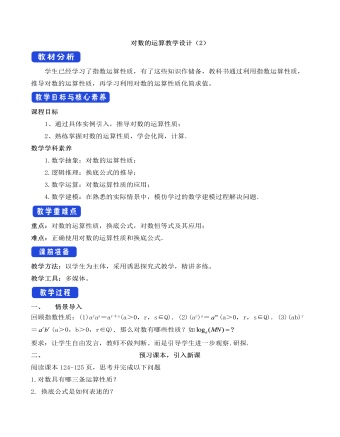
人教A版高中数学必修一对数的运算教学设计(2)
学生已经学习了指数运算性质,有了这些知识作储备,教科书通过利用指数运算性质,推导对数的运算性质,再学习利用对数的运算性质化简求值。课程目标1、通过具体实例引入,推导对数的运算性质;2、熟练掌握对数的运算性质,学会化简,计算.数学学科素养1.数学抽象:对数的运算性质;2.逻辑推理:换底公式的推导;3.数学运算:对数运算性质的应用;4.数学建模:在熟悉的实际情景中,模仿学过的数学建模过程解决问题.重点:对数的运算性质,换底公式,对数恒等式及其应用;难点:正确使用对数的运算性质和换底公式.教学方法:以学生为主体,采用诱思探究式教学,精讲多练。教学工具:多媒体。一、 情景导入回顾指数性质:(1)aras=ar+s(a>0,r,s∈Q).(2)(ar)s= (a>0,r,s∈Q).(3)(ab)r= (a>0,b>0,r∈Q).那么对数有哪些性质?如 要求:让学生自由发言,教师不做判断。而是引导学生进一步观察.研探.
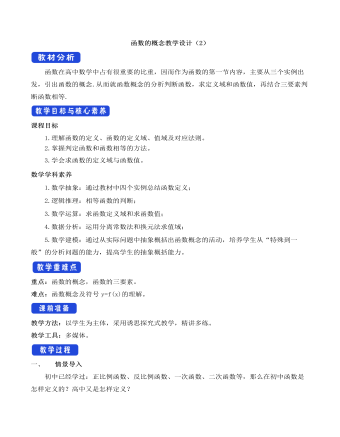
人教A版高中数学必修一函数的概念教学设计(2)
函数在高中数学中占有很重要的比重,因而作为函数的第一节内容,主要从三个实例出发,引出函数的概念.从而就函数概念的分析判断函数,求定义域和函数值,再结合三要素判断函数相等.课程目标1.理解函数的定义、函数的定义域、值域及对应法则。2.掌握判定函数和函数相等的方法。3.学会求函数的定义域与函数值。数学学科素养1.数学抽象:通过教材中四个实例总结函数定义;2.逻辑推理:相等函数的判断;3.数学运算:求函数定义域和求函数值;4.数据分析:运用分离常数法和换元法求值域;5.数学建模:通过从实际问题中抽象概括出函数概念的活动,培养学生从“特殊到一般”的分析问题的能力,提高学生的抽象概括能力。重点:函数的概念,函数的三要素。难点:函数概念及符号y=f(x)的理解。

人教A版高中数学必修一集合的概念教学设计(2)
例7 用描述法表示抛物线y=x2+1上的点构成的集合.【答案】见解析 【解析】 抛物线y=x2+1上的点构成的集合可表示为:{(x,y)|y=x2+1}.变式1.[变条件,变设问]本题中点的集合若改为“{x|y=x2+1}”,则集合中的元素是什么?【答案】见解析 【解析】集合{x|y=x2+1}的代表元素是x,且x∈R,所以{x|y=x2+1}中的元素是全体实数.变式2.[变条件,变设问]本题中点的集合若改为“{y|y=x2+1}”,则集合中的元素是什么?【答案】见解析 【解析】集合{ y| y=x2+1}的代表元素是y,满足条件y=x2+1的y的取值范围是y≥1,所以{ y| y=x2+1}={ y| y≥1},所以集合中的元素是大于等于1的全体实数.解题技巧(认识集合含义的2个步骤)一看代表元素,是数集还是点集,二看元素满足什么条件即有什么公共特性。
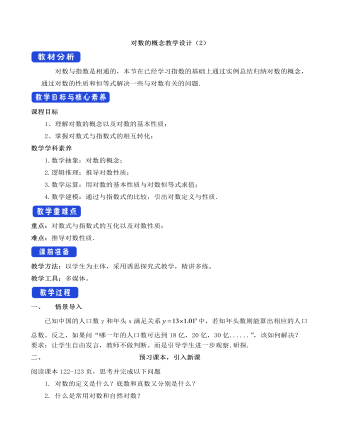
人教A版高中数学必修一对数的概念教学设计(2)
对数与指数是相通的,本节在已经学习指数的基础上通过实例总结归纳对数的概念,通过对数的性质和恒等式解决一些与对数有关的问题.课程目标1、理解对数的概念以及对数的基本性质;2、掌握对数式与指数式的相互转化;数学学科素养1.数学抽象:对数的概念;2.逻辑推理:推导对数性质;3.数学运算:用对数的基本性质与对数恒等式求值;4.数学建模:通过与指数式的比较,引出对数定义与性质.重点:对数式与指数式的互化以及对数性质;难点:推导对数性质.教学方法:以学生为主体,采用诱思探究式教学,精讲多练。教学工具:多媒体。一、 情景导入已知中国的人口数y和年头x满足关系 中,若知年头数则能算出相应的人口总数。反之,如果问“哪一年的人口数可达到18亿,20亿,30亿......”,该如何解决?要求:让学生自由发言,教师不做判断。而是引导学生进一步观察.研探.
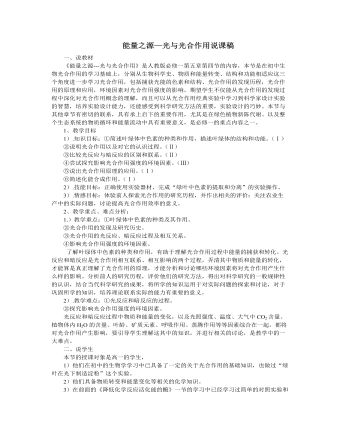
人教版高中生物必修1能量之源—光与光合作用说课稿
1)他们在初中的生物学学习中已具备了一定的关于光合作用的基础知识,也做过“绿叶在光下制造淀粉”这个实验。2)他们具备物质转变和能量变化等相关的化学知识。3)在前面的《降低化学反应活化能的酶》一节的学习中已经学习过简单的对照实验和相关的实验设计原则,使本节课最后的实验设计得以顺利进行。4)他们具有一定的 分析问题的能力,实施问题探究教学是可行的。三、教法和学法根据上述对教材和学生的分析,本节采用以下教法和学法:1)实验法:以实验说明结论。生物学的教学就是实验的教学过程,实验的展示形式有学生分组实验、老师示范实验、动画和图片演示实验等,让实验现象说明问题,而不是直接让学生记住结论。2)问题探究教学发:以问题引发兴趣。整个教学过程要设置好问题,层层展开,层层递进,让新知识与旧知识融为一个整体,让学生在步步上升中攀登到知识的顶峰。3)比较学习法,同时采用多媒体辅助教学,解决光合作用抽象的过程。
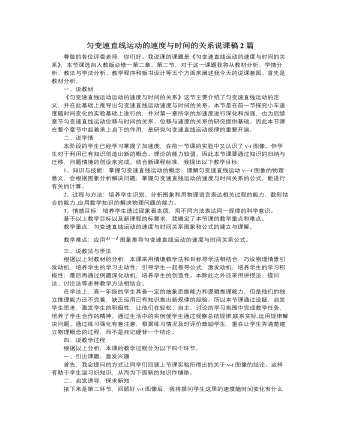
人教版新课标高中物理必修1匀变速直线运动的速度与时间的关系说课稿2篇
设计意图:几道例题及练习题,其中例1小车由静止启动开始行驶,以加速度 做匀加速运动,求2s后的速度大小?进而变式到:小车遇到红灯刹车……,充分体现了“从生活到物理,从物理到社会”的物理教学理念;例题及练习题由浅入深、由易到难、各有侧重,体现新课标提出的让不同的学生在物理上得到不同发展的教学理念。这一环节总的设计意图是反馈教学,内化知识。(6) 小结归纳,拓展深化我的理解是,小结归纳不应该仅仅是知识的简单罗列,而应该是优化认知结构,完善知识体系的一种有效手段,为充分发挥学生的主题作用,从学习的知识、方法、体验是那个方面进行归纳,我设计了这么三个问题:① 通过本节课的学习,你学会了哪些知识;② 通过本节课的学习,你最大的体验是什么;③ 通过本节课的学习,你掌握了哪些学习物理的方法?
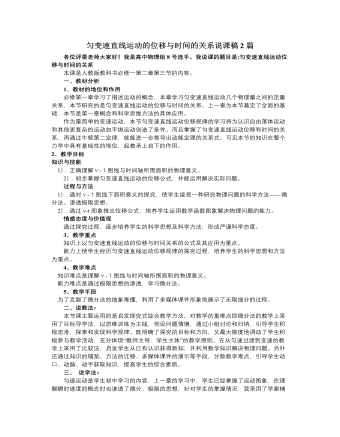
人教版新课标高中物理必修1匀变速直线运动的位移与时间的关系说课稿2篇
培养学生合作交流意识和探究问题的能力,这一部分知识层层递进,符合学生由特殊到一般、由简单到复杂的认知规律。4、互动探究(1)极限思想的渗透让学生阅读“思考与讨论”小版块.培养学生的自学和阅读能力提出下列问题,进行分组讨论:a、用课本上的方法估算位移,其结果比实际位移大还是小?为什么?b、为了提高估算的精确度,时间间隔小些好还是大些好?为什么?针对学生回答的多种可能性加以评价和进一步指导。让学生从讨论的结果中归纳得出:△t越小,对位移的估算就越精确。渗透极限的思想。通过小组内分工合作,讨论交流,培养学生交流合作的精神,以及搜集信息、处理信息的能力;通过小组间对比总结,使学生学会在对比中发现问题,在解决问题过程中提高个人能力;
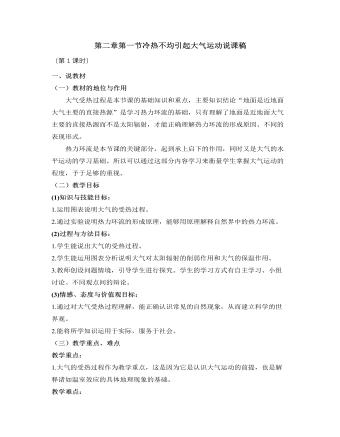
人教版高中地理必修1第二章第一节冷热不均引起大气运动说课稿
4、【自主探究】巴山夜雨的成因③材料三:三国时期,诸葛亮于农历6月的一天,在葫芦峪设下伏兵,打算用火攻全歼司马懿。这一天,晴空万里暑热难耐,真乃火攻之良机。诸葛亮依计将司马懿之众诱入谷中……然而,正当大火冲天,司马懿全军行将覆灭之时,一场大雨不期而至,大雨浇灭了诸葛亮扶汉反魏的壮志,使他喊出了“谋事在人,成事在天,不可强也”的千古悲歌。【设计理念】前后呼应,发散思维。通过自主探究,学生各抒己见,完成对热力环流整个知识框架的一个总结,既考查了学生的课堂学习效果,又锻炼了学生知识的迁移能力,并认识生活中的地理规律,用生动的语言拉近学生与大气理性知识的距离,体会到地理学科的重要性。【提问】如果将白天换成夏季,将夜间换成冬季,情况又会怎样?城市与郊区之间也存在着热力环流——城市风,它们是怎样形成的?了解城市风的出现有何重要意义?如果地球上在赤道和两极之间存在热力环流,这个热力环流应该怎样?这几个问题,请大家课后慢慢思考。
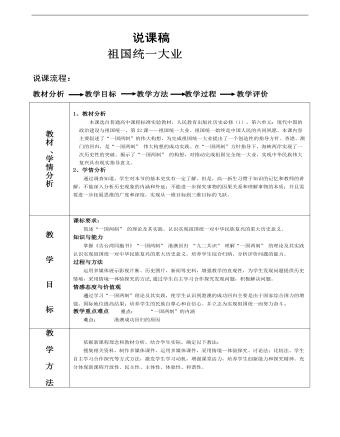
高中历史人教版必修一《第22课祖国统一大业》说课稿
1、教材分析 本课选自普通高中课程标准实验教材,人民教育出版社历史必修(1),第六单元:现代中国的政治建设与祖国统一,第22课——祖国统一大业。祖国统一始终是中国人民的共同夙愿。本课内容主要叙述了“一国两制”的伟大构想,为完成祖国统一大业提出了一个创造性的指导方针。香港、澳门的回归,是“一国两制” 伟大构想的成功实践。在“一国两制”方针指导下,海峡两岸实现了一次历史性的突破。揭示了“一国两制” 的构想,对推动完成祖国完全统一大业,实现中华民族伟大复兴具有现实指导意义。 2、学情分析通过调查知道,学生对本节的基本史实有一定了解。但是,高一新生习惯于知识的记忆和教师的讲解,不能深入分析历史现象的内涵和外延;不能进一步探究事物的因果关系和理解事物的本质;并且需要进一步拓展思维的广度和深度,实现从一维目标到三维目标的飞跃。
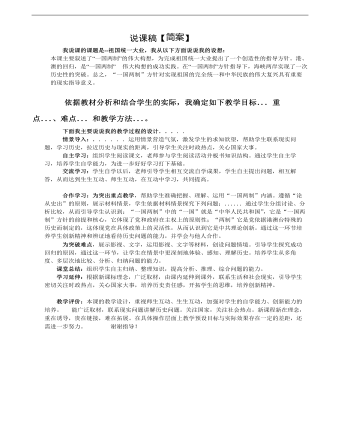
高中历史人教版必修一《第22课祖国统一大业(简案)》说课稿
情景导入:......运用情景营造气氛,激发学生的求知欲望,帮助学生联系现实问题,学习历史,拉近历史与现实的距离,引导学生关注时政热点,关心国家大事。自主学习:组织学生阅读课文,老师参与学生阅读活动并板书知识结构。通过学生自主学习,培养学生自学能力,为进一步好好学习打下基础。交流学习:学生自学以后,老师引导学生相互交流自学成果,学生自主提出问题,相互解答,从而达到生生互动、师生互动,在互动中学习,共同提高
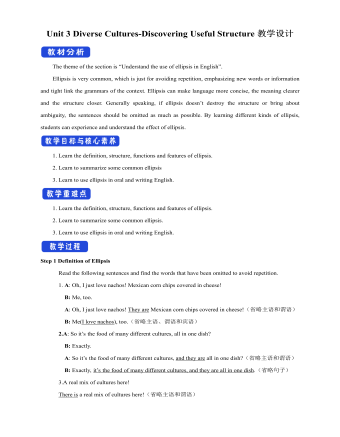
新人教版高中英语必修3Unit 3 Diverse Cultures-Discovering Useful Structure教学设计
Step 4 PracticeRead the conversation. Find out which words have been left out.Justin: Linlin, I’m going to Guizhou Province next month. I’m super excited! Any recommendations for places to visit?Linlin: Wow, cool! Guizhou is a province with a lot of cultural diversity. Places to visit...well, definitely the Huangguoshu Waterfall first.Justin: What’s special about the waterfall?Linlin: Well, have you ever heard of the Chinese novel Journey to the West ?Justin: Yes, I have. Why ?Linlin: In the back of the waterfall, you will find a cave, which is the home of the Monkey King.Justin: Really? Cool! I’ll definitely check it out.Linlin:And I strongly recommend the ethnic minority villages. You’ll find Chinese culture is much more diverse than you thought.Justin:Sounds great, thanks.Answers:Justin: Linlin, I’m going to Guizhou Province next month. I’m super excited! Do you have any recommendations for places to visit?Linlin: Wow, that’s cool! Guizhou is a province with a lot of cultural diversity. What are some places to visit in Guizhou ? Well, definitely the Huangguoshu Waterfall is the first place to visit in Guizhou Province.Justin: What’s special about the waterfall?Linlin: Well, have you ever heard of the Chinese novel Journey to the West ?Justin: Yes, I have heard of the Chinese novel Journey to the West . Why do you ask if I have heard of the Chinese novel Journey to the West?Linlin: In the back of the waterfall, you will find a cave, which is the home of the Monkey King from Journey to the West.Justin: That’s really true? It’s Cool! I’ll definitely check it out.Linlin:And I strongly recommend the ethnic minority villages on your trip to Guizhou Province. You’ll find Chinese culture is much more diverse than you thought it was.Justin:This all sounds great, thanks.
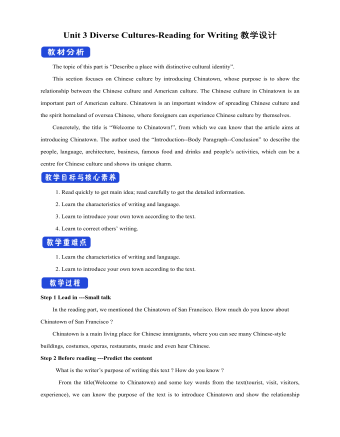
新人教版高中英语必修3Unit 3 Diverse Cultures-Reading for Writing教学设计
The topic of this part is “Describe a place with distinctive cultural identity”.This section focuses on Chinese culture by introducing Chinatown, whose purpose is to show the relationship between the Chinese culture and American culture. The Chinese culture in Chinatown is an important part of American culture. Chinatown is an important window of spreading Chinese culture and the spirit homeland of oversea Chinese, where foreigners can experience Chinese culture by themselves.Concretely, the title is “Welcome to Chinatown!”, from which we can know that the article aims at introducing Chinatown. The author used the “Introduction--Body Paragraph--Conclusion” to describe the people, language, architecture, business, famous food and drinks and people’s activities, which can be a centre for Chinese culture and shows its unique charm.1. Read quickly to get main idea; read carefully to get the detailed information.2. Learn the characteristics of writing and language.3. Learn to introduce your own town according to the text.4. Learn to correct others’ writing.1. Learn the characteristics of writing and language.2. Learn to introduce your own town according to the text.Step 1 Lead in ---Small talkIn the reading part, we mentioned the Chinatown of San Francisco. How much do you know about Chinatown of San Francisco ?Chinatown is a main living place for Chinese immigrants, where you can see many Chinese-style buildings, costumes, operas, restaurants, music and even hear Chinese.Step 2 Before reading ---Predict the contentWhat is the writer’s purpose of writing this text ? How do you know ?From the title(Welcome to Chinatown) and some key words from the text(tourist, visit, visitors, experience), we can know the purpose of the text is to introduce Chinatown and show the relationship between Chinese culture and American culture.
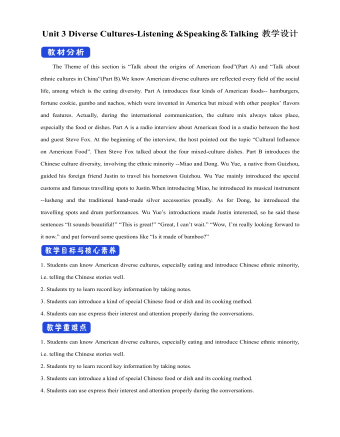
新人教版高中英语必修3Unit 3 Diverse Cultures-Listening &Speaking&Talking教学设计
1. In Picture 1 and Picture 2, where do you think they are from? How do you know?From their wearings, we can know they are from ethnic minority of China--- Miao and Dong.Picture 1, they are playing their traditional instrument lusheng in their traditional costumes.Picture 2. the girls are Miao because they wear their traditional costumes and silver accessory.2. In Picture 3, can you find which village it is? What time is it in the picture?It is Dong village. It is at night. Step 2 While-listeningJustin met a new friend while traveling in Guizhou. Listen to their conversation and complete the summaries below.Part 1Justin and Wu Yue watched some Miao people play the lusheng. The instrument has a history of over 3,000 years and it is even mentioned in the oldest collection of Chinese poetry. Then they watched the lusheng dance. Justin wanted to buy some hand-made silver/traditional accessories as souvenirs. He was told that the price will depend on the percentage of silver. Part 2They will go to a pretty Dong minority village called Zhaoxing. they will see the drum towers and the wind and rain bridges. They may also see a performance of the Grand Song of the Dong people.Step 3 Post-listening---TalkingWork in groups. Imagine Justin is telling some friends about his trip to Guizhou. One of you is Justin and the rest of you are his friends. Ask Justin questions about his trip and experience. The following expressions may help you.
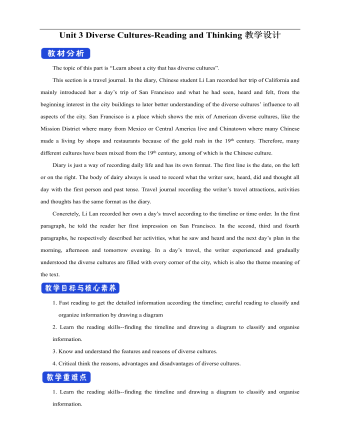
新人教版高中英语必修3Unit 3 Diverse Cultures-Reading and Thinking教学设计
Discuss these questions in groups.Q1: Have you ever been to a place that has a diverse culture ? What do you think about the culture diversity ?One culturally diverse place that I have been to is Harbin, the capital city of Heilongjiang Province. I went there last year with my family to see the Ice and Snow Festival, and I was amazed at how the culture as different to most other Chinese cities. There is a big Russian influence there, with beautiful Russian architecture and lots of interesting restaurants. I learnt that Harbin is called “the Oriental Moscow” and that many Russians settled there to help build the railway over 100 years ago.Q2: What are the benefits and challenges of cultural diversity ?The benefits: People are able to experience a wide variety of cultures, making their lives more interesting, and it can deepen the feelings for our national culture, it is also helpful for us to learn about other outstanding culture, which helps improve the ability to respect others. The challenges: People may have trouble communicating or understanding each other, and it may lead to disappearance of some civilizations and even make some people think “The western moon is rounder than his own.”Step 7 Post reading---RetellComplete the passage according to the text.Today, I arrived back in San Francisco, and it feels good (1) _____(be) back in the city again. The city succeeded in (2)_________ (rebuild) itself after the earthquake that (3)________ (occur) in 1906, and I stayed in the Mission District, enjoying some delicious noodles mixed with cultures. In the afternoon, I headed to a local museum (4)____ showed the historical changes in California. During the gold rush, many Chinese arrived, and some opened up shops and restaurants in Chinatown to earn a (5)_____ (live). Many others worked on (6)______ (farm), joined the gold rush, or went to build the railway that connected California to the east. The museum showed us (7)____ America was built by immigrants from (8)________ (difference) countries and cultures. In the evening, I went to Chinatown, and ate in a Cantonese restaurant that served food on (9)________(beauty) china plates. Tomorrow evening, I’m going to (10)__ jazz bar in the Richmond District. 答案:1. to be 2. rebuilding 3. occurred 4. that 5.living6. farms 7.how 8. different 9. beautiful 10. a
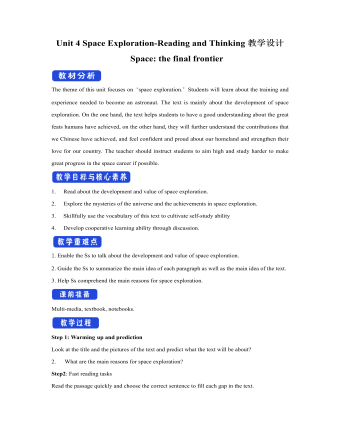
新人教版高中英语必修3Unit 4 Space Exploration-Reading and Thinking教学设计二
The theme of this unit focuses on “space exploration.” Students will learn about the training and experience needed to become an astronaut. The text is mainly about the development of space exploration. On the one hand, the text helps students to have a good understanding about the great feats humans have achieved, on the other hand, they will further understand the contributions that we Chinese have achieved, and feel confident and proud about our homeland and strengthen their love for our country. The teacher should instruct students to aim high and study harder to make great progress in the space career if possible.1. Read about the development and value of space exploration.2. Explore the mysteries of the universe and the achievements in space exploration.3. Skillfully use the vocabulary of this text to cultivate self-study ability 4. Develop cooperative learning ability through discussion.1. Enable the Ss to talk about the development and value of space exploration.2. Guide the Ss to summarize the main idea of each paragraph as well as the main idea of the text.3. Help Ss comprehend the main reasons for space exploration. Multi-media, textbook, notebooks.Step 1: Warming up and predictionLook at the title and the pictures of the text and predict what the text will be about?2. What are the main reasons for space exploration?





















